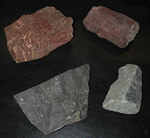Home | Session 3 | Franciscan Formation Pg 1, 2, 3, 4
The Franciscan Formation: Where the Rock and Plate Tectonic Cycles Converge
Presented
by Lisa White
San Francisco State University
Franciscan Rock Types
Igneous
Basalt
Basalt is an extrusive igneous rock type that is a common seafloor rock that typically forms from volcanic eruptions along mid-ocean ridges. The distinctive, rounded, "pillow" structures that are common in Franciscan Complex basalts are consistent with structures that form from submarine lava flows. Basalt outcrops in the City can be viewed at Twin Peaks, which is part of the Marin Headlands terrane.Sedimentary
Sedimentary rocks are the most common Franciscan Complex units and consist of both clastic rocks, such as greywacke, and biogenic rocks, such as chert.
Graywacke
Greywacke is an immature, poorly sorted sandstone containing grains of angular rock fragments. It is often called a "dirty sandstone" and typically forms as a result of turbid, mud and sand-laden flows along steep continental slopes associated with subduction zones. Outcrops of greywacke are common at Baker Beach (Hunters Point mélange) and the Cliff House (San Bruno Mountain terrane).Chert
Red-colored chert is probably the most recognizable rock in the Franciscan Complex. Thinly alternating beds of chert and shale produce what is commonly called ribbon chert. The cherts formed as a result of slow settling of shells of radiolaria, a single-celled zooplankton with a silica shell, forming siliceous oozes on the deep seafloor. Chert outcrops in the City can be nicely viewed in the Twin Peaks and Mt. Davidson areas, which are part of the Marine Headlands terrane.Metamorphic
Serpentinite
The most unusual rock in the Franciscan Complex is serpentinite, a rock that forms from alteration of oceanic crust and upper mantle rocks that are rich in magnesium and iron. (Click to zoom in on an example at left.) Serpentinite contains many unusual minerals that form during hydrothermal alteration producing its characteristic green-blue mottled appearance. The presence of serpentinite, along with the other Franciscan rocks types, confirms that these basement rocks of the Coast Ranges were formed as a result of subduction of an oceanic plate (the Farallon plate). During the process, part of the oceanic plate was "obducted" or accreted to the continental margin as material was scraped-off the down-going plate. In addition to the buoyant sediments that were accreted to the margin in wedges producing the characteristic Franciscan Complex terranes, part of the ocean floor was fractured and dismembered as it was added to the plate margin producing a classic "ophiolite sequence."
updated February 6, 2002
UCMP Home | What's new | About UCMP | History of Life | Collections | Subway
